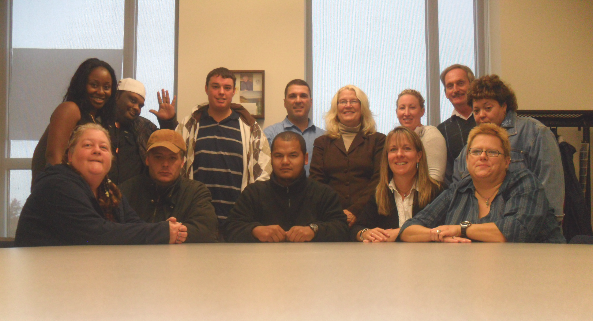You are here
 Alternatives, a large human service agency in central Massachusetts, initiated a pilot project called “The Employment Academy” to introduce employment and education options to people served by the agency. The project served both people with psychiatric conditions (n=9) and people with developmental disabilities (n=10), participating on separate days, and included three components: classroom experience, social interaction, and job shadowing. We will describe the outcomes for people with psychiatric conditions.
Alternatives, a large human service agency in central Massachusetts, initiated a pilot project called “The Employment Academy” to introduce employment and education options to people served by the agency. The project served both people with psychiatric conditions (n=9) and people with developmental disabilities (n=10), participating on separate days, and included three components: classroom experience, social interaction, and job shadowing. We will describe the outcomes for people with psychiatric conditions.
Collaborators for this project included the Alternatives staff, responsible for supported employment and education, Quinsigamond Community College (QCC), and local businesses in the city of Worcester, Massachusetts. Individuals were recruited to participate based on their expressed interest in working, although not all expressed a desire to get a job in the near future.
The Classroom Experience
The classroom experience component used the Boston University Choose-Get-Keep approach. Participants met for two mornings per week over six weeks—a total of eleven class sessions. Lunch coupons and a small weekly stipend were provided. Homework was assigned and participants completed their assigned worksheets. For the “choosing” phase, the class discussed positive reasons for working, potential employment areas of interest, and personal barriers to working. This was followed by a session on how to choose a job and a presentation on “soft skills.” Guest speakers were invited from a local employment agency, the local state vocational rehabilitation service, and “Dress for Success.” The “getting” phase of classroom instruction included mock interviews and a presentation on how benefits might be affected by employment. Two guest speakers shared their personal stories of how employment contributed to their own recovery. Finally, the “keeping” phase of the class addressed employer expectations for success on the job, and included a local employer as a guest speaker.
The Social Component
The social component of the Employment Academy involved informal connecting among participants and an orientation to QCC, including a presentation on the many social and recreational events held on campus. Participants were also introduced to the QCC Disability Services Office. A liaison was hired to educate participants about QCC services and events, and two student volunteers were recruited to provide support and to connect with participants during the breaks.
The Job Shadowing Component
The job shadowing component offered three choices at QCC: a clerical position in the Disability Services Office (photocopying, collating), a tutor in the Transition Center (a college service for people returning to the academic environment), and an office support worker in the Transition Center. Three additional experiences were available in the community; the Worcester Country Club offered the chance to experience food service and event set up, Wal-Mart made opportunities available in several departments, and Dress for Success provided experience working in their boutique. All of the job- shadowing experiences lasted approximately 1.5 hours each day.
Results
Eight of the nine participants with psychiatric conditions completed the full Employment Academy program. The person who dropped out went on to enroll at QCC. Two of the nine participants obtained jobs and two more are actively seeking employment two enrolled in GED programs, one applied for a work study position at QCC, and another participant was invited to hold an art show at the college.
Participants reported high satisfaction with the program. Specifically, they liked having a place to go every day, they enjoyed the campus atmosphere, and the guest speakers. The job shadowing experience received positive comment from participants, although they would have preferred more time on the job. They appreciated the weekly stipend, but still found costs a barrier—for example, while the participants had the opportunity to use the campus gym, the use fee was prohibitive. Transportation was also a challenge, and participants were consistently late. The mock interviews in the classroom were useful, but described as “nerve-wracking.”
Alternatives will be offering another Employment Academy soon. Some changes are planned, such as better coordination of transportation. Fewer job shadow sites or locating sites within a smaller geographic area will facilitate both transportation and job site support.



